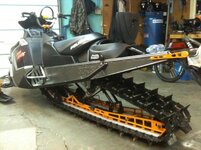There are some people out there that may want to powdercoat the entire PRO-RMK/Assault/RUSH chassis.
Powder coating is, ironically, baked at 400 degrees F.... which is the approx "release" temp of the adhesive used in boding the PRO Chassis.... Lord 406/19 Acrylic adhesive.
This MAY be OK because of the additional bolts used in construction of the bonded components that will keep the assembly from moving during the baking process.
The essential part of the puzzle here is that the assemblies are not really moved or jarred while heated and before they come back to normal temps and that the entire assembly is well supported.
Powder coating is, ironically, baked at 400 degrees F.... which is the approx "release" temp of the adhesive used in boding the PRO Chassis.... Lord 406/19 Acrylic adhesive.
This MAY be OK because of the additional bolts used in construction of the bonded components that will keep the assembly from moving during the baking process.
The essential part of the puzzle here is that the assemblies are not really moved or jarred while heated and before they come back to normal temps and that the entire assembly is well supported.
Powder Coating after Bonding with LORD® 400 Series
Acrylic Adhesives
The LORD® 400 series acrylic adhesives have excellent heat resistance characteristics up to 400°F (204°C), reducing the concern of possible degradation of the cured adhesive due to heat during the powder coating process. (There is data for heat resistance at 400°F [204°C] up to 1000 hours.)
However, it is important to keep in mind that at these higher temperatures, the hot tear strength is very low. The lower strength values make it essential that the assembly is properly fixtured or placed to avoid slippage of the bonded pieces, especially if they are heavy in nature. Spot welds are frequently used in the industry to hold the assembly in place.
The integrity of the bond will remain unchanged, and in fact increase, once the assemblies have returned to room temperature.
A frequently asked question is “Why does the adhesive look orange/tan in color after exposure to heat instead of the light green we are accustomed to seeing after normal room temperature cure?” This color change can typically occur because of the higher temperatures seen during typical painting and E-coat processes.
The integrity of the bond after either one of these processes should remain unchanged, and in fact increase, once the assemblies have returned back to room temperature.
Last edited:



